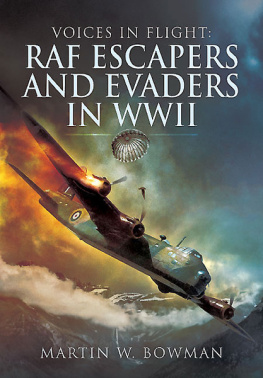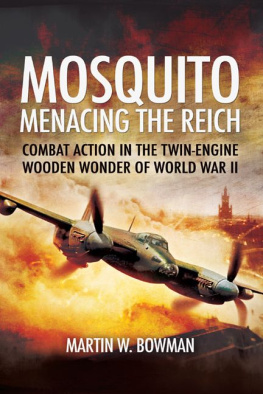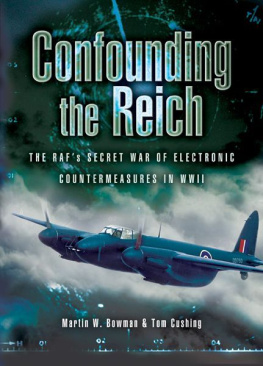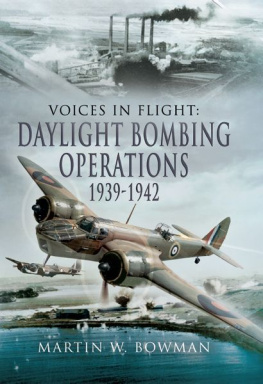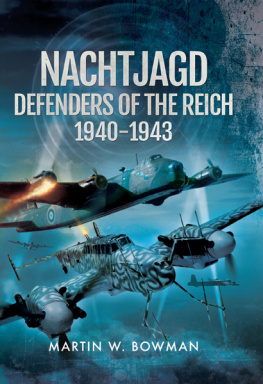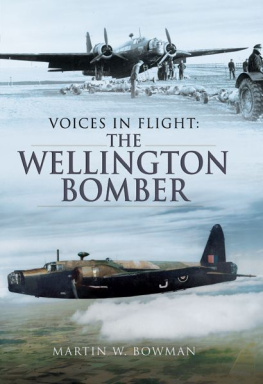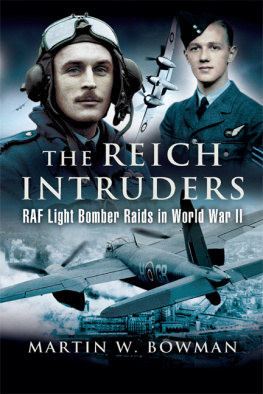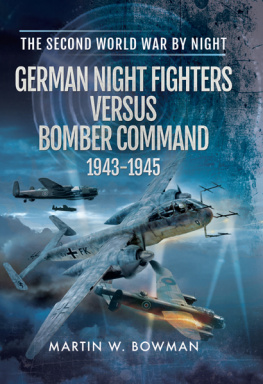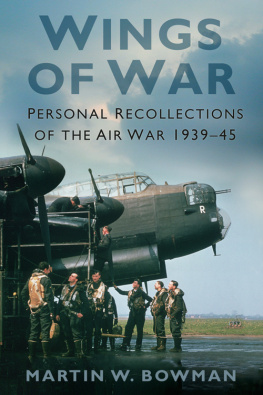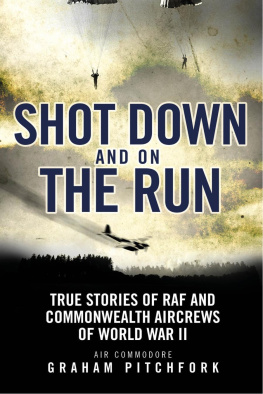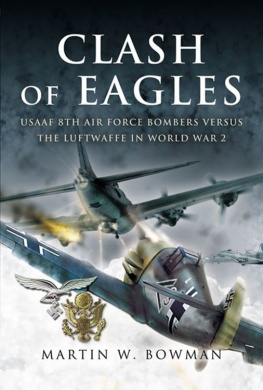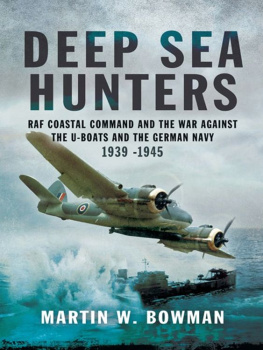First Published in Great Britain in 2014 by
Pen & Sword Aviation
an imprint of
Pen & Sword Books Ltd
47 Church Street, Barnsley, South Yorkshire S70 2AS
Copyright Martin W Bowman, 2014
ISBN: 9781783831753
EPUB ISBN: 9781473850477
PRC ISBN: 9781473850545
The right of Martin W Bowman to be identified as author of this work
has been asserted by him in accordance with the Copyright,
Designs and Patents Act 1988.
A CIP catalogue record for this book is
available from the British Library.
All rights reserved. No part of this book may be reproduced or transmitted
in any form or by any means, electronic or mechanical including
photocopying, recording or by any information storage and retrieval system,
without permission from the Publisher in writing.
Typeset in 10/12pt Palatino
by GMS Enterprises
Printed and bound in England by
CPI Group (UK) Ltd, Croydon, CR0 4YY
Pen & Sword Books Ltd incorporates the Imprints of Pen & Sword
Aviation, Pen & Sword Family History, Pen & Sword Maritime, Pen & Sword
Military, Pen & Sword Discovery, Wharncliffe Local History, Wharncliffe
True Crime, Wharncliffe Transport, Pen & Sword Select, Pen & Sword
Military Classics, Leo Cooper, The Praetorian Press, Remember When,
Seaforth Publishing and Frontline Publishing.
For a complete list of Pen & Sword titles please contact
PEN & SWORD BOOKS LIMITED
47 Church Street, Barnsley, South Yorkshire, S70 2AS, England
E-mail:
Website: www.pen-and-sword.co.uk
Contents
- David Masters/BBC |
- A. J. Evans MC |
- George R. Harsh RCAF |
- W. Newton MBE |
- W. H. Marshall DFC DFM |
- Roy Bradley |
- Flight Sergeant Len Manning |
- Flying Officer John P. Wheeler |
Acknowledgements
I am indebted to all the contributors for their words and photographs, especially Len Manning. Thanks also go to my fellow author, friend and colleague, Graham Simons, for getting the book to press ready standard and for his detailed work on the photographs; to Pen & Sword in particular, Charles Hewitt and Laura Hirst; and to Jon Wilkinson, for his unique jacket design once again.
Prologue
Truth Is Stranger Than Fiction
David Masters/BBC
I hope you will forgive me this evening if I bring in a personal note. For Im going to introduce to you an old friend of mine. Actually we were learning to fly together in 1913 before the last war. We trained together at the civil schools at Hendon on some of the curious and primitive machines of those early days - the comic box kites and the funny little monoplanes which if they got off the ground at all staggered along painfully at about 50 mph - rather different from the Wellingtons and the Hurricanes of today. But all the same, as you will hear later, it seems to have been quite a useful sort of training. Well, this friend of mine served all through the last war as a pilot in the RFC and the RAF and in 1918 ended up as a Wing Commander with the DSO, the MC and the DFC for his distinguished services. Although he left the RAF after the war he kept up flying and from then onwards took an active and prominent part in civil aviation. Then, at the beginning of the present war, although now fifty years of age, he felt that he was still capable of doing a useful job of work in the air as an active pilot, so he joined up again in the RAF - but this time as a pilot officer, the equivalent of a second lieutenant. How far he was justified in doing this you will be able to judge for yourselves from an account he is going to give you of an exciting incident in France in which he took part the other day and for which he was awarded a bar to the DFC he had won twenty-two years ago.
BBC Broadcast, July 1940
In April 1940 after he had given convincing proof that he could fly, Louis Arbon Strange DSO MC DFC was granted his commission as a Pilot Officer. He must have given some of the officials a headache, for he was rather a problem. The rules and regulations laid down that he could not fly and rules and regulations must be obeyed. Then some genius discovered that the regulations applied only to government aircraft and not to those hired or requisitioned from commercial firms for government use and Pilot Officer Strange was therefore able to fly on operations instead of sitting in an office chair. As the young pilot who first tested him suggested, it really was rather funny; but it has its serious side to those who realize that only by utilizing all the ability of outstanding men in the proper manner will this nation and civilization survive.
No man in the whole service was happier than Colonel Strange when he donned the uniform of the Royal Air Force again as Pilot Officer Strange. The nightmare of the past six months, of trying to get money out of the Treasury to pay wages, of coping with difficulties day after day, was over. He was back in the service he loved, helping the country. His responsibilities had fallen away from him. The wing commander of the last war was glad to be the pilot officer of this. Within weeks of his rejoining the Royal Air Force the Germans vanquished Holland and Belgium and began to roll back the French. Under the German pressure the bases of the British squadrons operating in France were continually being shifted. Pilots flew until they were nearly overcome with fatigue; aircraft - men toiled all the time to make adjustments and service the aircraft in order to keep the fighting pilots in the air. It was impossible to take either pilots or aircraft men off their operational duties to flyaway or repair the aircraft collected in the aerodromes further back. The British army, moving rapidly and fighting night and day, called for rations; the tanks and anti-tank guns kept up an insatiable demand for ammunition. Such were the conditions pertaining in the latter half of May which led to one more remarkable exploit on the part of Colonel Strange. As supplies were being demanded and several damaged aircraft were grounded at Merville aerodrome, it was decided on 23 May to send Colonel Strange over to Merville with a fleet of civil aircraft to deliver supplies and a party of mechanics to effect temporary repairs to any aircraft in order to get them home.
It was a fine morning when they took off from an aerodrome somewhere in England and headed for the Channel across which Colonel Strange had flown so often in the old days of war and peace. His pilot, Bill Ledlie, who was famous in civil aviation, knew his way about the air lanes of the continent as surely as a London bus driver knows his way from Oxford Circus to Marble Arch. The tragic panorama of war unfolded as Colonel Strange looked down on the roads of France. Refugees on foot and in cars were streaming along, the cars looking ridiculously like sheep owing to the fact that they mostly had mattresses rolled up and fastened to the top of them. Flying over the woods in the direction of Ste-Omer he noticed a lot of popping noises and concluded that they were passing over machine-gun and rifle ranges where the French soldiers were practising. The glow of tracer bullets soon made him realize that they were being attacked from the ground. A short distance ahead were a dozen German tanks drawn up under some trees on the outskirts of a village, with the black swastika painted in a white circle on their brown and green camouflaged tops. The pilot dived down at them just over the tree tops, while the German crews began frantically to cover the tanks with camouflage nets. Transport vehicles were parked all around and at the sight of the British aeroplane the German soldiers bolted for the cover of the ditches and opened fire on the aircraft.
Next page
